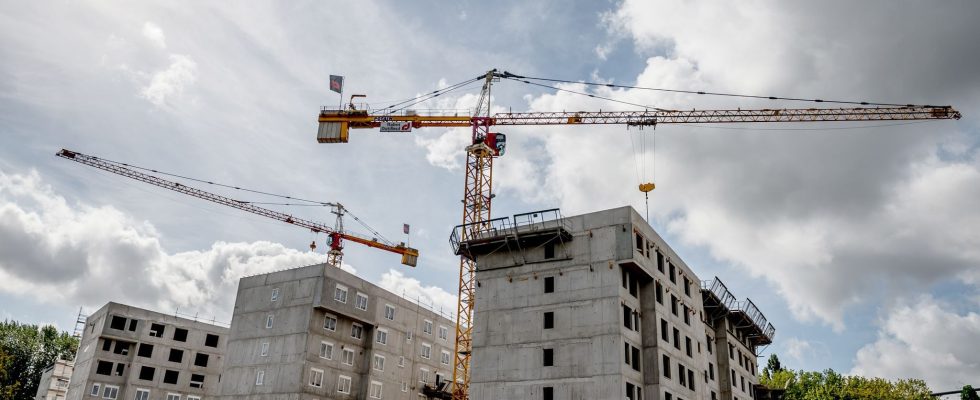Housing. A primary need that is struggling to be satisfied in France in 2023. And the situation is not about to improve. Already subject to multiple constraints – environmental standards, high land prices, rent controls, etc. – the real estate sector is today disrupted by the rise in rates. Our explanations and ways to break the impasse in this six-part special report.
The figures are overwhelming and professionals are dismayed. When presenting his quarterly statistics in mid-November, the president of the Federation of Real Estate Developers, Pascal Boulanger, did not mince his words. “Last year, I thought we had hit rock bottom. I even thought I was being a bird of ill omen by announcing a difficult 2023. Difficult is an understatement. We are hardly selling anything anymore.” During the summer, the number of new homes put up for sale collapsed by half compared to 2022. As for reservations, they fell by 30%. The fault is demand curbed by rising rates and loan refusals.
Some social housing players buy back unsold units, but developers leave their margin there, deplores the Federation. Aspiring property owners are deserting. Investors in rental property too: at the end of September, over a year, their reservations had halved. Among institutional investors, it is the performance that slows down enthusiasm. As for individuals, who were considering buying new properties as an investment for their retirement, the tax carrot is losing its flavor. “For buyers, the government’s decision to extend the zero-interest loan in tense areas goes in the right direction, judges Olivier Durix, at Bouygues Immobilier. But the tax exemption schemes linked to stone are more effective in supporting the walk.” Alas, Emmanuel Macron and Elisabeth Borne no longer want to hear about it: ineffective and too costly for public finances. With the extinction of Pinel at the end of 2024, with no announced successor, France is preparing to end forty years of romance between taxpayers and the intermediate rental stock.
Locked land market
The issuance of building permits having fallen by 30% in one year, the market is therefore not about to rebound. “Promoters no longer have equity and debt is more expensive, they are no longer launching projects, which will accentuate the shortage,” warns Guillaume Poitrinal, former boss of Unibail and co-founder of WO2. Olivier Colonna d’Istria, president of the Institute for Financing Real Estate Professionals (IFPImm), confirms: “The decline in volumes in 2023 will continue in 2024 and 2025, because developers cannot build cheaper. ” The cost of land, materials and energy constrain the cost price. “Reviving housing requires easier access to land, blocked in particular by municipal development companies,” says Philippe Zivkovic, co-founder of WO2. Not sure that the amendment retained in the 2024 budget – a reduction of at least 60% on the added value made by the seller of building land, in tense or intermediate areas – is enough to loosen the grip.
All-round regulations also complicate the task, and inflate the bill. “Standards for people with reduced mobility, environmental standards… Even in hyper-urban areas, it is necessary to produce a “fauna and flora” survey, which can extend the process of obtaining the permit by twelve months,” denounces Guillaume Poitrinal. Once the key is won, the game is far from won. Make way for the avalanche of appeals. Among the Anglo-Saxons, we speak of the Nimby syndrome, “Not in my backyard”, “Not in my house!”, proclaim the residents who are resistant to the new neighbors. “This phenomenon has exploded. Permits are increasingly under attack and citizens are putting pressure on local elected officials,” laments urban planner David Miet.
Where have the building mayors gone? The reluctance of those administered leads to inaction. An additional building and residents mean additional public services to finance. In the city councilors’ defense, the abolition of the housing tax significantly complicates their budgetary equation. “Too often, the response of elected officials consists of sacrificing height, to make the real estate project acceptable, points out the president of Ogic Virginia Bernoux. Let’s convey the message that density is not negative. One more class in a school or new green spaces benefit everyone.”
Allow densification
David Miet regrets the law for access to housing and renovated urban planning (Alur) of 2014, which offered the advantage of protecting agricultural land, while promoting densification. “But in a few years, elected officials and town planners have found other tools to prohibit construction. The ZAN – zero net artificialization – is more ambitious to preserve the fields but it has no counterpart. At the same time, the population should be increased cities.” The government has launched a program in this direction. With the result being 30,000 new homes in three years. It is off the mark.
Because the needs are there, increased by changes in lifestyles and the aging of the population. “We have lost the sense of demographic developments, worries Nicolas Théry, the boss of Crédit Mutuel. Three million homes should be built by 2030, due to family patterns which mean that one person in two lives alone today. This effect has been hidden. Basically, we are building half of the 500,000 housing units that we would need each year.”
Rehabilitation and changes of use are alternatives. “In Ile-de-France, there are 2.5 million square meters available in office areas, which could allow the creation of 40,000 housing units,” points out Olivier Durix, at Bouygues Immobilier. But the process is complex and requires modifying the local urban planning plan (PLU). “We can also question the need for a PLU to qualify the use of a building,” observes Olivier Colonna d’Istria, at IFPImm. One more obstacle to overcome.
.
